This blog interview originally appeared on Þæt Eald-Ænglisce Blog, or The Old English Blog. Thanks to Christopher for letting me republish it.
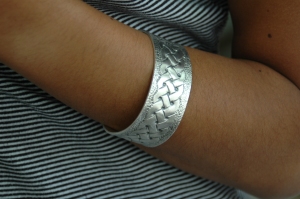 Over the past couple decades, a new vitality has re-entered the study of history. More and more people are reading history for leisure, attending historically themed events, and participating in ‘living history’ groups and historical reenactments. Somewhere between the professional archeologists and lay historians are those individuals who, while not necessarily holding postgraduate degrees and the like, nonetheless attempt to authentically replicate aspects of the past through experimentation, using authentic resources, materials, and methods.
Over the past couple decades, a new vitality has re-entered the study of history. More and more people are reading history for leisure, attending historically themed events, and participating in ‘living history’ groups and historical reenactments. Somewhere between the professional archeologists and lay historians are those individuals who, while not necessarily holding postgraduate degrees and the like, nonetheless attempt to authentically replicate aspects of the past through experimentation, using authentic resources, materials, and methods.
Jamie Hall, the creator and author of Primitive Method, is one such person. For the past year Jamie, who works in the jewelry trade at his father’s shop in Derby, has been publishing posts about his research into and practise of the techniques of medieval jewelry making. The chased interlace bangle (above), the anticlastic bangle (below left) and Celtic twist bangles (below right) are just four items produced by Jamie using the “old ways”.
Quite graciously, Jamie agreed to be interviewed to discuss his Primitive Method project, how the project has changed him as a jeweler, and the reality of medieval jewelery making past and present. And so without further ado, let’s get to the interview.
A little under 6 years ago, I was offered a job by my father, who is a self-taught manufacturing jeweller in Derby. Initially, I worked in the shop, but I gradually began to do the final polishing of items – a dirty and time-consuming job – and I slowly began to do more and more work. I’ve always joked that I did a medieval apprenticeship, rather than a Modern Apprenticeship (a UK vocational training program), because I spent a lot of time cleaning out the machines and making cups of tea.
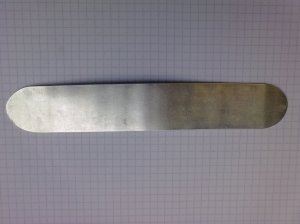
Synclastic Bangle: a long sheet of silver can be made into a synclastic bangle. The ends are rounded to make it comfortable to take on and off.
Although we’re a small firm, we have some cutting-edge equipment, and combined with some traditional fabrication skills, this allows us to compete with the large high-street jewellers. Having a real workshop is a great selling point, and from talking to friends on the retail side of the trade, I began to realise how import it is to have real, practical skills.
We produce a range of different types of jewellery, but most commonly we make wedding and engagement rings, using a mixture of casting and fabricating. My particular area of speciality is finishing – that’s polishing, buffing and electroplating.
How did you first get the idea to study the old techniques of medieval jewelers? What did you initially hope to achieve or learn? Have your goals changed over the course of the project? Have you met any of your goals along the way?
I’ve always had an interest in medieval history. I think it’s a very iconic era, and there’s a certain patriotic appeal to looking at the Anglo-Saxons, Vikings and Normans. That didn’t make it a foregone conclusion that I’d start working with archaic skills, though; I used to think the work I do now was an impossible thing – hammering out wire, for example, which takes a lot of time, but who does that nowadays?
There were lots of factors that pushed me to do this, but the two main things are the frustration at my inability to do more in the modern workshop, and my wife’s pregnancy last year (we now have a lovely daughter, called Millie). I knew that I had to do something to make my work unique, and make it better, than other jewellers. I also knew that I had to be outside my comfort zone if I was going to achieve anything.
Broadly, I’ve stayed the course so far. The goalposts do shift on a monthly basis, depending on what facilities I have access to, and how much time I have, but I’m happy with my progress. I probably haven’t learnt as much in a year as I had hoped, but in truth, I expect it to be another 4 years before I’m fully capable – that will make it 10 years as a jeweller, too, and these things take time.
From what you have learned so far, in what ways does medieval jewelry making differ from modern practices? Have any old techniques of merit been lost to modern jewelers?
Many of the skills are basically the same, but people tend to reach for the high-tech machine before they reach for a hammer. This is a critical point for skills – the good news is that there is a growing interest in alternatives to mass production, but when you combine the lack of apprenticeships in the last 30 years with the affordability of CAD/CAM, it really could go either way,
The work of the medieval jeweller was all about time – without electricity to speed up and improve techniques, lots of labourers and apprentices were needed; the garnet inlay technique seen in the Sutton Hoo and Staffordshire Hoard finds is seen as being incredible and unachievable by many jewellers now, but it just takes time and effort. That’s not me claiming to be able to do it, mind you – many of the archaeological finds from that period do put our modern abilities to shame.
I think that social and environmental factors are more significant than any changes in tools or abilities. Sheet metal is slow to make with a hammer, and so the Anglo-Saxons didn’t use a lot of it, but they were still capable of making larger sheets for plates and bowls when they needed. Casting was more commonly used for large pieces of jewellery, and although the techniques of modern casting use better materials, all of the processes are fundamentally the same.
We really need to look at ancient craftsmanship in a different way – it isn’t something that separates us: it’s intimately connected with contemporary artisans. We’re just a point on the same timeline that the Anglo-Saxons were.
You stated in your blog that the reason you do your research is to improve your work as a jeweler. Have you found that your work has indeed improved? If so, in what ways?
It has made a big difference. My work ethic has been changed by it, and I feel prouder of what I’m doing. I’m much quicker to use small hand tools now, instead of resorting to machinery. There’s a lot of repetition in medieval crafting, and that’s profoundly useful – after thousands of hammer strikes, I’m finally beginning to hit straight (I mean really straight, and I’m still not quite there), and I’m more aware of the shape and condition of the hammers now. I’ve forged foil in fine silver that’s just one twentieth of a millimetre thick, which is thin enough to use in the garnet cloissoné I mentioned earlier.
One particular area of change is polishing. Modern polishers use high-speed wheels to give a mirrored shine to metal, but the techniques require several thousand RPM, which can only be achieved with electricity. In the past, the impression of glittering brightness had to achieved by other means – brass or iron brushes could be used for a matt finish, or powdered minerals like charcoal and chalk could be rubbed on with fabric or leather, using progressively finer powders to reach a high gloss. The real trick is to avoid large plain areas of metal. Encrusting the surface with gems and filigree allows the jeweller to only polish the highlights, which is much less technically demanding, and for the same reason, engraving, stamping and chasing were used to add zoomorphic and interlaced patterns to fill in any gaps. If well-finished tools are used, they polish the metal themselves, and very little is done afterwards. In the modern world, people spend most of their time trying to clean up and polish the items that come from a machine at a much lower quality than the equivalent handmade object would do.
You also said in your blog that, “understanding older methods should really form the backbone of our training as metalsmiths – we need a basis from which to innovate, instead of blindly following processes we don’t understand.” Now that a year has passed since you started your research, do you still feel that understanding the older methods should be part of the training of a modern jeweler?
This is quite a controversial subject. Everyone will agree that artisans need as many skills as they can, but not everyone values the kind of archaic methods that I favour. Personally, I think it should form the backbone of any jewellery education – it’s important to know how good modern equipment is, and you don’t realise that unless you work without it.
Other people would say that we shouldn’t worry about outdated, slow and complicated methods, on the basis that people should focus on the potential of new technologies.

The edges of the bangle as gently and evenly hit with a hammer - this trues up the whole piece, and to some extent it hides any asymmetry. It's then rubbed with charcoal, followed by a burnisher. This is more bronze age than medieval, but it's important to master these basic forms before attempting more complicated work.
I’d like to see a situation where people were being taught to feel like they are part of a tradition, and that they can be an active practitioner. Many of the basic ideas, like tool-making and hand-forging, are very cheap and make it possible for aspiring jewellers to set up their own practice with much less money.
The other area that would really benefit is jewellery repair. This is a major component of my work as a modern jeweller, and the ancient skills provide you with a greater understanding of the structural and visual restoration of an item, and this is something that graduates are sorely lacking, in my opinion. It’s such a financially rewarding part of the job, and there’s plenty of repair work out there that needs doing – obviously, it lacks the glamour of art jewellery and bespoke work, but it does pay the bills.
What is the current status of your project? What plans do you have for the future of your project?
I’m currently insanely busy. On the strength of the blog, I got an arts residency at Loughborough University School of the Arts, on a programme called AA2A. I’ve had full access to their metalworking rooms, which include a fantastic collection of anvils and stakes (used for shaping sheet metal), and a wide selection of hammers and other hand tools. Plus they’ve got a blacksmithing hearth, so there’s plenty of scope for toolmaking. There’s a work-in-progress exhibition in March for that. I haven’t been posting on the blog quite as much in the last few months, but it’s because I’ve been doing a lot more, and researching a lot less. When I get a quiet period, I’ll hopefully write up what I’ve been doing at Loughborough.

Before the advent of drawplates for making round wire, it was easier to cut the edge off thin sheet and coil it round a rod as neatly as possible. The more evenly cut the strip is, the better.
I’ve got several things coming up this year. I’ll be writing for Benchpeg.com, which is an online jewellery newsletter for the UK trade, and I’ve got several applications to make for bursaries and residencies. I’ll also have to start looking into exhibiting more of my work. Everything seems to be going well at the moment, but I worry sometimes that I’m in a funny place, professionally – the project is too practical to be archaeology or fine art history, but too educational to be art in the normal sense of the word – finished works are less important to me than the process required to make them, but I clearly need people to see me as an artist, so I’ll be making an effort with public relations – hopefully giving lectures, and doing more interviews like this one.
What are your long-term goals as a jeweler? Do you believe your work in learning the old techniques will be of any substantial benefit in achieving those goals?
There are a few avenues open to me. I expect to carry on with the Primitive Method in one form or another for the forseeable future, ideally making commissions and selling through exhibitions, but there is also the family business, and my family must obviously come first. I’ll always be at the mercy of money, which is sort of ironic, because without money, society wouldn’t provide me with any customers for this kind of specialised work.

The coil is twisted by handing, making it longer and thinner. It's hard to believe that this will turn into wire, but it will.
People always talk about having a USP – a unique selling point – and I think my work will make people look at me differently. With that in mind, it might seem odd that I share the skills and knowledge I am learning, but I don’t think my USP will be “Anglo-Saxon jeweller”; it will be my experimental nature that makes me special.
This summer, I’m hoping to convert an outbuilding at home into a primitive forge. It was my plan for last summer, but time got away from me. There’s a limit to what I can do at home – sustained hammering wouldn’t be fair on the neighbours, but there are lots of things that I’d like to do, like casting silver using a charcoal hearth. I’ve also been talking to some reenactors; I’m intending to do some Living History demonstrations at some point this year.
Do you think it would be possible to financially support oneself as a jeweler if one used only the old techniques? For example, would the extra time involved in creating each piece make the ultimate price of any particular item prohibitively expensive for customers?
I think that there is a tiny, tiny percentage of the world population that is willing to pay well for fine craftsmanship. If I’m very lucky, I’ll be able to sell my work to those people, and further fund the Primitive Method, but the truth is that most customers can’t afford to pay me to spend 10 hours hammering when I could buy silver sheet out of a catalogue. But I don’t have to use all the skills all the time. It will make sense to sell several grades of work – some of it as perfect historical reproductions, some of it as completely modern work, and lots of things that fall inbetween, with contemporary design, but mostly using traditional skills. Style is an important issue here – medieval styles attract many people visually, but not everyone wants to wear them – it will be necessary to keep skills alive by using them to make jewellery that’s more appealling to the modern eye.

The coil is then hand-rolled between two hard surfaces, like wood, metal or stone, regularising the thickness. See how the gaps are wider in places - this is due to imperfections in the original coiling.
The pace of the work is much slower, and there is always debate in the jewellery trade over how much the artisans time is worth, but it isn’t cheap. When you consider what you pay a plumber or joiner to work on your house, you can see how the costs of making hand-forged jewellery would quickly become prohibitive.
One definite benefit of traditional skills is the ability to quickly change the direction of the business – spending £25,000 on a CAD/CAM system ties you to using it, and prohibits many people from starting to use it. With the skills of the Anglo-Saxon jeweller behind me, I’ll be able to make anything – no two days need be the same, and that has to be a good thing for the future of my profession.
Is there anything else you would like to mention or tell readers?
For anyone interested in this sort of work, there are a few books that I’d like to recommend. My personal favourite is a 12th century book called ‘On Divers Arts‘ by Theophilus Presbyter, who was an artisan-monk in Germany – it describes painting, glasswork and jewellery, and constitutes the first real workshop handbook written by a practitioner (ignoring a couple of bizarre chapters, like how to breed basilisks).
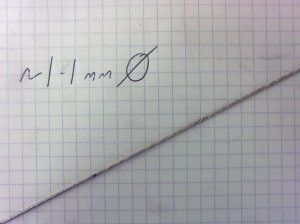
Eventually, the wire reaches a limit, beyond which the weight and force from your arms is not enough. At this point, you have to STAND on the rolling blocks, is use your entire bodyweight to further compress the wire. Incredibly, it can take your body weight without collapsing, even though the wire is hollow. You can get it down to about 0.9mm alone - with help, it should be possible to apply even more pressure, and get it thinner still.
Sadly, there are no detailed primary texts on jewellery for the Anglo-Saxon period, but a couple of modern books I’d suggest are ‘The Art of the Anglo-Saxon Goldsmith‘ by Coatsworth and Pinder, and ‘Anglo-Saxon Crafts‘ by Kevin Leahy. The latter is a less scholarly text than the former, but it does give a broad view of blacksmithing, leatherworking, woodworking, pottery and weaving, all of which are relevant to the jeweller.
If you can cope with books from a latter period, Cellin’s ‘Treatise on Goldsmithing and Sculpture‘ is a good Italian text from the Renaissance, as is ‘De la Pirotechnia‘ by Biringuccio, which provide a wealth of technical descriptions of metallurgy and metalworking. I’m always on the lookout for interesting books, so I’d welcome any recommendations that people can send me.
And now here is a step-by-step guide by Jamie on how to turn a cast circular ingot of fine silver into decorated fine silver foil.
A cast circular ingot of fine silver is cleaned up by filing and scraping any cavities away. A domed punch is used to open out any large cavities (those are the round holes). Ideally, the work should be cleaned with lye (caustic soda) and water and then put in acid for a while. Before the advent of strong, fast acids like sulphuric acid, you could have used citrus juice (lime is best) or vinegar, and left it for a few days instead of a few hours.
The ingot is hammered, taking 2 or 3 hours. The holes disappear, and the main focus is on keeping it as round as possible. You can see that the ingot starts out about the same size as the steel stake, and gets larger as it gets thinner.
At about 1.1mm, dividers are used to mark out a circle, and shears are used to cut it. This is surprisingly easy to do, and only requires a little filing afterwards to give a neat circle. A modern jeweller would generally use a piercing saw to do this. A piece like this could be used to make a disc brooch, or raised to make a small bowl or chalice.
Instead of stopping around 1mm, you can keep on going, and make the sheet thinner and thinner, eventually turning it into foil.
STEP 5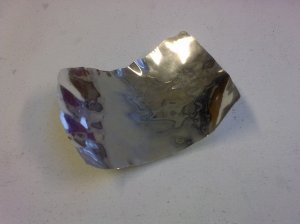 This is about 0.2mm thick, which is the point at which you’d stop calling it sheet, and start calling it foil. If you want to apply a pattern, this is still a bit thick. The shiny surface comes from using a well polished hammer.
This is about 0.2mm thick, which is the point at which you’d stop calling it sheet, and start calling it foil. If you want to apply a pattern, this is still a bit thick. The shiny surface comes from using a well polished hammer.
This is about 0.05mm thick – that’s 1/20th of a millimetre – and a burnisher and/or charcoal is used to brighten the surface of the silver. By folding the foil it’s possible to stiffen the material (which is very delicate), or the burnisher (pictured) can be rubbed on the fold to remove a section – it’s too thin to separate with shears.
A dog’s head rubbed into the foil with a blunt spike, alternating between the front and back to give height and depth to the surface of the foil.
*****
I wish to give a heartfelt thanks to Jamie Hall for his agreeing to do this interview as well for the wonderful answers and photographs he provided. Jamie shows us how the past has much to teach us even nowadays, and how one can make the past relevant in the present. I’m sure I speak for everybody when I wish him the best of luck and much success in his endeavors. For anybody interested in contacting Jamie directly, here are his contact details:
Jamie Hall
Location: Burton-on-Trent, UK
Website: http://primitive.userblogs.ganoksin.com
Twitter: @primitivemethod
Email: primitive.method@yahoo.com
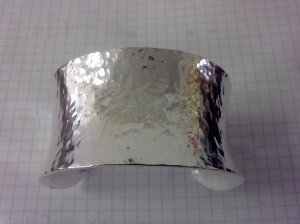
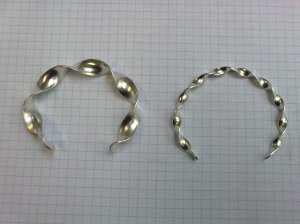
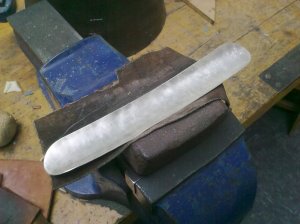
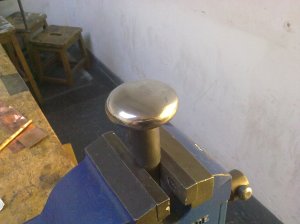

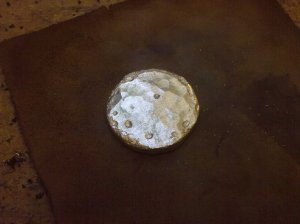
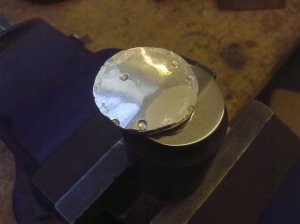
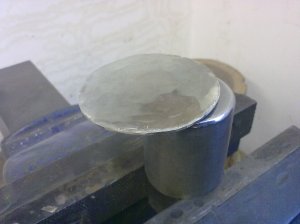

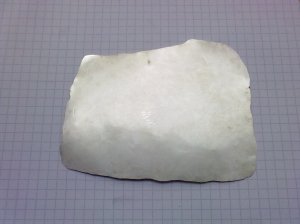
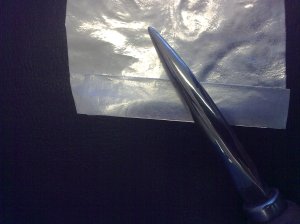

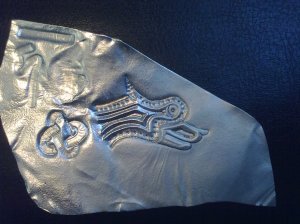
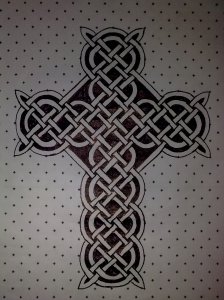
Comments on this entry are closed.
{ 1 trackback }